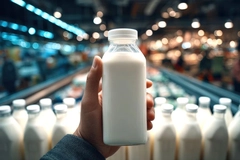Cutting-edge technology yields depositing accuracy and savings
21 Apr 2011

Hinds-Bock’s Patented MSBO Spouts with multiple cycling cutting spool, allows for clean deposits of difficult to handle products like fruit fillings, pie fillings and turnovers.
Hinds-Bock’s Patented MSBO Spouts with multiple cycling cutting spool, allows for clean deposits of difficult to handle products like fruit fillings, pie fillings and turnovers.
What are some of Hinds-Bock’s latest technological advances in the Baking industry?
Patented MSBO Spouts, C.I.P., hygienic design, higher speeds, more accurate deposits, quick changeovers and advanced control. These are just a few of their latest advances. Patented MSBO Spouts allow for clean deposits of difficult to handle products like fruit fillings, pie fillings and turnovers. They feature positive shut off, unique circumferential cutting spool, and PLC (programmable logic controllers) controlled multiple cycling of cutting spool. CIP (clean in place) servo pump fillers sanitize themselves. Not only are there fewer parts to clean, but the front cover plates are hinged for rapid sanitation swab testing.
Hygienic Design: Hinds-Bock servo pump fillers are designed with sanitation in mind. All flat surfaces are angled. Round tubing replaces square, and all over-lapping or recessed surfaces have been redesigned, eliminating the pooling of water.
How has new technology affected depositing and filling equipment?
With respect to depositing and filling equipment, the greatest impact technology has had is with the controls. Through the years, technological advancements in controls have driven the cost down and greatly increased the acceptance of PLCs, operator interfaces, plant-wide interfaces and servo motors. Through this technological leap, depositing and filling machines run faster and are easier to troubleshoot, sequence and control. This improvement in technology led to more sophisticated depositing and filling machine integrations than would not have been practical years ago with outdated mechanical and air pilot controls.
Describe the automated features that enable a muffin depositor to produce 18,000 lb. per hour?
The largest muffin lines typically fill multiple pockets in multiple pans simultaneously, and the conveying and indexing of these pans is handled by a large, substantial conveyor. This conveyor uses controls that recognize each flight of the conveyor and sequences additional automation, such as tray placers, paper cup denesters, pan oiler, dry ingredient depositors and streusel depositors. These features include a PLC, pan sensors, shaft encoder and operator interface.
How can depositors address variable-speed lines?
Variable speed lines typically are equipped with a shaft encoder, which feeds pulses to the PLC integrated within the depositor's control platform. As the conveyor speeds up or slows down, the depositor automatically adjusts its speed to match that of the conveyor. This is quite common on depositing lines where the spouts or the entire depositor travels with the pan or the target during the deposit cycle, which increases the speed of the depositing line and ensures clean deposits and proper deposit shapes.
How can depositors and fillers be customized to accommodate lines with multiple product changeovers?
Hinds-Bock 12P-06 high speed depositors are ideal for applications like sweet goods as-well-as mini muffins, snack cakes and brownies. These multi-piston machines can deposit up to 1,000 units per minute.
Most U.S. bakeries use the same line to run multiple pans and products. Several key features allow the depositors to be rapidly changed over from one pan or product to the next. Often, machines are manufactured with positive shut-off spouts. The centerline of these positive shut-off spouts can be quickly adjusted without tools by simply moving a cam lever and sliding the spout to the proper centerline. The automatic cycling controls integrate within the depositor's control platform and automatically adjust the pan pitch. This change is made by simply accessing the SKU number with the operator interface panel. The deposit weight can be adjusted manually by turning a handwheel, or automatically by pushing a button. Further automation is integrated with an upstream or downstream checkweigher.
How has automation of depositing and filling equipment improved production efficiency for bakers?
The automation of depositing and filling equipment leads to a quantifiable improvement in uptime, increasing efficiency in yield for the bakeries that operate these machines. This uptime is typically tracked and documented. Modern depositors incorporate features for rapid sanitizing, which minimizes downtime between product changeovers. Modern controls speed up the troubleshooting process as compared to the older style of mechanical or pneumatic air pilot controls.
Source: Hinds-Bock Corporation
All content and features on this website are copyrighted with all rights reserved. The full details can be found in our privacy statement
Subscribe to our newsletters
By continuing to browse our site you agree to our Privacy Statement











